My first real introduction to simulations of naval warfare was Avalon Hill's Jutland, released in the late 1960's. My brother and I spent many a pleasant afternoon reenacting the German dreadnoughts' titanic struggle to wrest control of the North Sea from the British Grand Fleet.
I was fascinated by the detailed counters provided with the game. The counters were about 2" long and .5" wide with beautiful overhead depiction's of each ship. I remember being impressed by the number of turrets on the WW I ships. I was used to seeing only three or four turrets on most WW II battleships. I always wondered how and why the turret layouts had evolved.
The all big gun standard caliber battleship has existed for almost 100 years now. Many people take this for granted and forget bow revolutionary and risky this concept was when it surfaced at the beginning of the 20th century. While it may be hard to believe today, the building of the British and German dreadnoughts and superdreadnoughts strained the technological limits of the day. These new ships were a complete break with naval tradition and new approaches were explored as the technology advanced and made different designs feasible.
Several different factors drove the move to all big guns of a standard caliber. The Russo-Japanese War of 1905 demonstrated that the standard ranges at which naval vessels could engage each other were getting larger and larger. Salvo firing and spatting the fall of shot, which facilitated long range fire control, also tended to increase the stress on the need for bigger guns. Coupled with this was the desire to maximize the destructive impact of individual shells.
There were several critical factors that effected turret layout besides the technological capability of the ship building industry. The weight of the turret, the size of the ship, the cost of the different layouts, and the current philosophy for how the ships would fight are relatively obvious. Another critical factor that is frequently overlooked is the blast effect of firing these large caliber guns.
I had no exposure to the physical effect of firing large guns until several years ago. I got a small idea of what blast effect was like when I attended a live fire demonstration at the Army's Aberdeen Proving Grounds in Aberdeen Maryland. I was amazed to physically feel the passage of the pressure wave created when the tanks and artillery were fired, even though I was about 75 yards from the guns! The biggest gun that was fired was a 155mm (6") artillery piece, significantly smaller than the 11' to 15' guns on the dreadnoughts!
The first 'dreadnought' was the H.M.S. Dreadnought launched in 1906, which carried 12' guns in twin turrets. The primary design goals for the Dreadnought was to develop a turret layout that secured a high percentage of 'all around' fire, fire to either broadside along with freedom from blast effects between individual turrets. The problem of blast effect was a major consideration in all plans considered. Blast restricted the total number of guns that could be effectively carried and eliminated some of the initial designs.
The final turret layout had a forward turret, two forward wing turrets, a stern turret, and an aft centerline turret between the forward wing turrets and the stern turret. (I will be using the counters from Avalon Hills' Jutland game to illustrate turret layouts. (BD note: on the diagrams showing the arcs of fire, the origin point is the center of the ship. Chris said that he could not get exact angle information so the diagrams are educated estimates.
The numbers represent the number of guns that could fire in the arc. The arcs labeled bow, stern, etc. are the limits to the corresponding turrets arc of fire, i.e. how far to the stern the bow turret could fire.) Before this layout was accepted the design had a pair of aft wing turrets instead of the aft centerline turret. The aft centerline turret was substituted for the aft wing turrets after the Admiralty reviewed an analysis of the potential blast curves
 The layout of the turrets on Dreadnought allowed three turrets to fire directly ahead. The sides of the raised forecastle, where the forward turret was located, were well recessed to minimise blast when the wing turrets fired directly ahead.
The layout of the turrets on Dreadnought allowed three turrets to fire directly ahead. The sides of the raised forecastle, where the forward turret was located, were well recessed to minimise blast when the wing turrets fired directly ahead.
The Dreadnought had the same basic fire arcs as the Belleropon. If you look at the fire arcs for the turrets, there are broad arcs ahead and astern where only two turrets (4 guns) could bear, the bow and stern turrets plus one of the wing turrets.
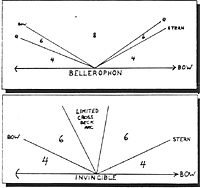 Only when firing directly ahead or astern can three turrets be brought to bear. On either side of these two arcs there is a small arc where three turrets (6 guns) can bear, and end turret, a wing turret, and the aft centerline turret. A total of four turrets (8 guns) can fire into a broad arc amidships.
Only when firing directly ahead or astern can three turrets be brought to bear. On either side of these two arcs there is a small arc where three turrets (6 guns) can bear, and end turret, a wing turret, and the aft centerline turret. A total of four turrets (8 guns) can fire into a broad arc amidships.
In the fire arc diagrams I have tried to indicate the number of guns that could fire to the left or port side of the ship. The lines radiating out from the center of the fire diagram represent the limits of fire for different turrets. I have tried to label the arcs of fire.
When the British Navy began developing what became known as the 'battlecruiser', a primary concern was that the vessel could maximise its ahead firepower. As a result, when the Invincible class was developed in 1908 the turrets were laid out for maximum ahead fire unhindered by blast interference from individual turrets.
The adoption of close echelon turrets amidships on the Invincible class, was not intended to give the class the capability of an eight gun broadside. The anticipated blast effect was expected to limit the cross deck arc of fire and risk causing damage to vessel structures. As a result, the policy was to only use the wing turrets on their side of the vessel. It was only expected that the close echelon arrangement would allow the vessels to maintain a six gun broadside over a limited arc IF one of the sidship wing turrets was knocked out of action.
The Bellerophon class of 1908 had the same turret layout as the Dreadnought. While the St. Vincent class of 1910 was equipped with sore powerful 12" guns, the turret layout was almost identical to the Dreadnought class. The one change was to move the X and Y turrets 10 inches further apart because the new guns were larger.
When the second class of battlecruiser was developed in 1910, the Indefatigable class was enlarged and slightly modified from the Invincible. The hull was lengthened to provide wider spacing between the midship wing turrets to ensure increased cross deck arcs of fire. Even with the increased spacing between the wing turrets, the arcs were still restricted do to blast effect. The blast was a particular problem for the deck. Another effect of providing greater cross deck arcs of fire was that the end turrets had to be placed closer to the bow and the stern, which effected the vessel's handling qualities.
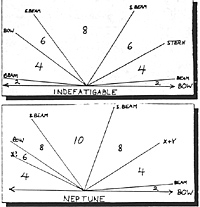 Blast effects also restricted the end on arcs of fire. The wing turrets could only fire to within five degrees of the centerline. This was accepted since the admiralty stated that the primary use of the main guns would be to broadside and that heavy end on fire would not be necessary. Achieving an adequate broadside was far sore important . This was an interesting change from the Invincible class.
Blast effects also restricted the end on arcs of fire. The wing turrets could only fire to within five degrees of the centerline. This was accepted since the admiralty stated that the primary use of the main guns would be to broadside and that heavy end on fire would not be necessary. Achieving an adequate broadside was far sore important . This was an interesting change from the Invincible class.
The Neptune in 1910 was not part of a class. There were some significant changes in the turret arrangement on the Neptune. One of the main purposes of the turret layout was to achieve a full ten gun broadside. Two main changes were made to try and achieve this.
The first change was to superimpose the fourth turret (X) over the fifth turret (Y). The second change was to echelon the midships turrets.
The two after turrets look like the typical turret arrangements that we have grown up associating with battleships. In 1910 however, this was a radical design. There were a number of problems associated with this arrangement. Surprisingly the arrangement was not intended to increase the firepower directly astern! Its main purpose was to save space and allow for wider arcs of fire on each broadside.
The big problem with the superimposed turrets was blast effect. Blast effect was so significant that the X turret could not fire directly over the lower Y turret! It was quite impossible to safely fire the X turret directly astern so stops were specifically placed to prevent the X turret guns from firing directly astern! In addition to the damage that would be done to the Y turret roof, the blast could give the turret observers severe concussions since the turret sighting ports were in special hoods mounted in the turret roof. I wasn't sure what the arc of fire was for the I turret so I took my best guess.
This vessel was also equipped with echeloned turrets. To provide some degree of cross deck firing a lot of the midship structure was cut away. The cross deck firing was restricted and in practice the deck amidships sagged badly as a result of blast. In practice the broadside was only slightly superior to that of the St. Vincent class.
While the forecastle sides were specially strengthened to permit nominal ahead fire for the wing turrets, the wing turrets couldn't fire within five degrees of the centerline. This restriction was again caused by problems with blast.
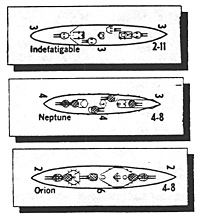 The Colossus class of 1911 were modified versions of the Neptune. This was the last class that carried 12" guns and echeloned turrets. The wing turrets were brought closer together. The class suffered the same blast effects as the Neptune. At Jutland when the 12" guns were fired across the deck, blast badly strained the amidships framing and deck supports. This was especially true when full charges were fired.
The Colossus class of 1911 were modified versions of the Neptune. This was the last class that carried 12" guns and echeloned turrets. The wing turrets were brought closer together. The class suffered the same blast effects as the Neptune. At Jutland when the 12" guns were fired across the deck, blast badly strained the amidships framing and deck supports. This was especially true when full charges were fired.
The Orion class was the first 'Super Dreadnought'. The Orion class was the first class armed with 13.5" guns and with all turrets placed on the centerline. The absence of beam turrets allowed the forecastle to extend the full width of the vessel until just before amidships. By angling the forecastle sharply to the centerline at that point the Q turret was given a larger arc of fire. There were two main factors that caused the Orion class to have all of its turrets on the centerline. First, the 13.5" guns made beam turrets impractical because of the significant increase in weight. Second , beam turrets severely limited the turrets' fire arcs.
The U.S. Michigan class of 1905 was the firs with all centerline turrets. The all centerline design was even considered for the Dreadnought, but was not considered feasible. At the time factors of weight, size, and cost effected this decision. The centerline arrangements of other foreign designs were carefully analyzed. The vessel had to be lengthened by 35' to accommodate the centerline turret arrangement.
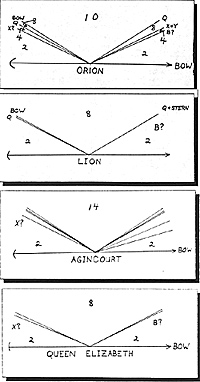 The King George V and Iron Duke classes were just refinements of the Orion class with only minor adjustments to the turret layout. The Erin, 1914, was also similar to the Orion class but had the Q turret one deck higher than the other classes. The Canada, 1914, was also based on the Orion design but had 14" guns mounted rather than 13.5" guns
The King George V and Iron Duke classes were just refinements of the Orion class with only minor adjustments to the turret layout. The Erin, 1914, was also similar to the Orion class but had the Q turret one deck higher than the other classes. The Canada, 1914, was also based on the Orion design but had 14" guns mounted rather than 13.5" guns
The Lion class of battlecruisers, like the Orion class, introduced the 13.5" guns and an all centerline turret arrangement. Like Orion it was the factors of the added weight of the 13.5" guns, and the addition of badly needed armor that forced the centerline design. The forward turrets were superimposed.
Unfortunately, the Q turret had a limited arc of fire.
The Tiger, 1914, reflected some important differences from the Lion class, because all of the boilers were grouped amidships, the Q turret was shifted aft of the third funnel.
This gave the Q turret the same basic arc of tire as the Y turret. In addition, since the Q turret was located significantly forward of the Y turret, the Q turret was able to fire directly aft over the Y turret. Blast damage was not a factor now because of the distance between the two turrets. This allowed 4 guns to fire in the after arc rather than just the 2 that the Lion could fire.
The Agincourt, 1914, also had an all centerline turret design. Since she carried only 12" guns she could mount seven turrets. She carried the largest number of large caliber guns ever carried on a battleship. The guns were carried in specially designed turrets and barbettes. The exceptional number of guns that could fire to either broadside created significant bull stress. In order for the design to accommodate the three quarter-deck turrets, special longitudinal girders had to be fitted.
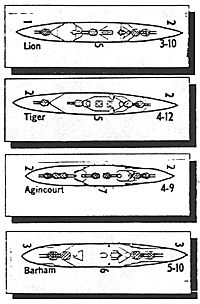 The Queen Elizabeth class, 1914, was the next logical evolution of the Orion design. Although they mounted only four turrets, the 15' guns gave them an increasingly powerful broadside. The weight of the four 15" turrets was equal to the weight of five 13.5" turrets.The four centerline turret design maximized the guns' arcs of fire.
The Queen Elizabeth class, 1914, was the next logical evolution of the Orion design. Although they mounted only four turrets, the 15' guns gave them an increasingly powerful broadside. The weight of the four 15" turrets was equal to the weight of five 13.5" turrets.The four centerline turret design maximized the guns' arcs of fire.
The Royal Sovereign class, 1916, was very similar to the Queen Elizabeth class. During the design process they considered using triple turrets but felt there wasn't enough experience with triple turrets. The class was designed to have wider arcs of fire than the Queen Elizabeth class but actual experience showed that the arcs of fire were almost the same, (Since the Queen Elizabeth and Royal Sovereign were not at Jutland, I used the counters for ships from their respective classes that were at Jutland). These two classes were the epitome of British battleship design. Their utility was proven by the fact that ships of these two classes were refitted and continued in service through the Second World War.
Main source of information came from:
British Battleships of World War One. by R.A. Burt. 1986 Arms L Armor Press Ltd. . Navel Institute Press Annapolis ND.
Back to Table of Contents The Messenger February 1994
Back to The Messenger List of Issues
Back to MagWeb Magazine List
© Copyright 1994 by HMGS/PSW.
This article appears in MagWeb.com (Magazine Web) on the Internet World Wide Web.
Other articles from military history and related magazines are available at http://www.magweb.com